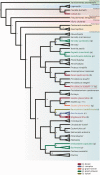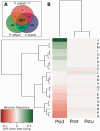Solving a Bloody Mess: B-Vitamin Independent Metabolic Convergence among Gammaproteobacterial Obligate Endosymbionts from Blood-Feeding Arthropods and the Leech Haementeria officinalis
- PMID: 26454017
- PMCID: PMC4684696
- DOI: 10.1093/gbe/evv188
Solving a Bloody Mess: B-Vitamin Independent Metabolic Convergence among Gammaproteobacterial Obligate Endosymbionts from Blood-Feeding Arthropods and the Leech Haementeria officinalis
Abstract
Endosymbiosis is a common phenomenon in nature, especially between bacteria and insects, whose typically unbalanced diets are usually complemented by their obligate endosymbionts. While much interest and focus has been directed toward phloem-feeders like aphids and mealybugs, blood-feeders such as the Lone star tick (Amblyomma americanum), Glossina flies, and the human body louse (Pediculus humanus corporis) depend on obligate endosymbionts which complement their B-vitamin-deficient diets, and thus are required for growth and survival. Glossiphoniid leeches have also been found to harbor distinct endosymbionts housed in specialized organs. Here, we present the genome of the bacterial endosymbiont from Haementeria officinalis, first of a glossiphoniid leech. This as-yet-unnamed endosymbiont belongs to the Gammaproteobacteria, has a pleomorphic shape and is restricted to bacteriocytes. For this bacterial endosymbiont, we propose the name Candidatus Providencia siddallii. This symbiont possesses a highly reduced genome with high A+T content and a reduced set of metabolic capabilities, all of which are common characteristics of ancient obligate endosymbionts of arthropods. Its genome has retained many pathways related to the biosynthesis of B-vitamins, pointing toward a role in supplementing the blood-restricted diet of its host. Through comparative genomics against the endosymbionts of A. americanum, Glossina flies, and P. humanus corporis, we were able to detect a high degree of metabolic convergence among these four very distantly related endosymbiotic bacteria.
Keywords: B-vitamin; Haementeria officinalis; Providencia siddallii; blood-feeder; genome reduction; leech endosymbiont.
© The Author(s) 2015. Published by Oxford University Press on behalf of the Society for Molecular Biology and Evolution.
Figures






References
-
- Akman L, et al. 2002. Genome sequence of the endocellular obligate symbiont of tsetse flies, Wigglesworthia glossinidia . Nat Genet. 32:402–407. - PubMed
-
- Apakupakul K, Siddall ME, Burreson EM. 1999. Higher level relationships of leeches (Annelida: Clitellata: Euhirudinea) based on morphology and gene sequences. Mol Phylogenet Evol. 12:350–359. - PubMed
Publication types
MeSH terms
Substances
Associated data
- BioProject/PRJEB6644
- Actions
- Actions
- Actions
- Actions
LinkOut - more resources
Full Text Sources
Other Literature Sources

